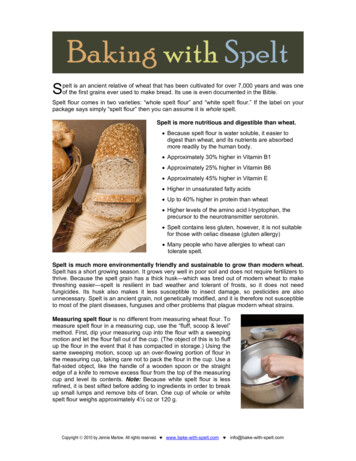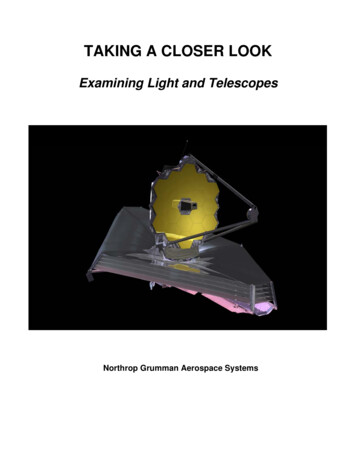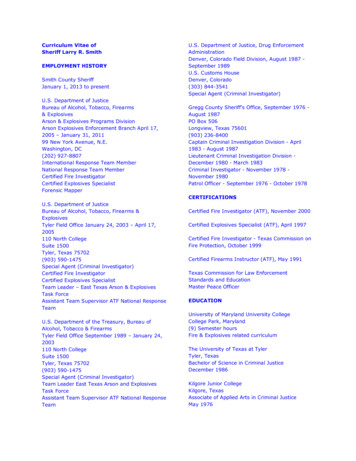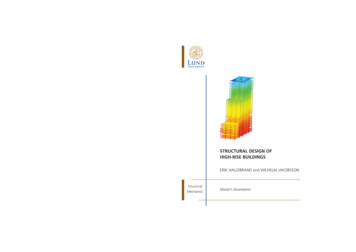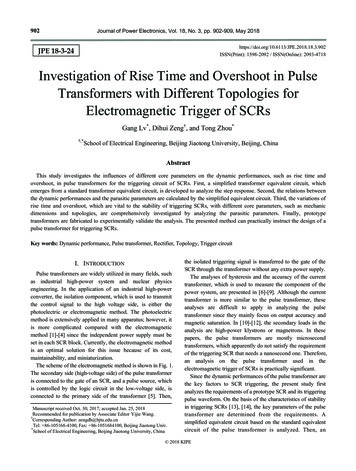
Transcription
902Journal of Power Electronics, Vol. 18, No. 3, pp. 902-909, May Print): 1598-2092 / ISSN(Online): 2093-4718JPE 18-3-24Investigation of Rise Time and Overshoot in PulseTransformers with Different Topologies forElectromagnetic Trigger of SCRsGang Lv*, Dihui Zeng†, and Tong Zhou*†,*School of Electrical Engineering, Beijing Jiaotong University, Beijing, ChinaAbstractThis study investigates the influences of different core parameters on the dynamic performances, such as rise time andovershoot, in pulse transformers for the triggering circuit of SCRs. First, a simplified transformer equivalent circuit, whichemerges from a standard transformer equivalent circuit, is developed to analyze the step response. Second, the relations betweenthe dynamic performances and the parasitic parameters are calculated by the simplified equivalent circuit. Third, the variations ofrise time and overshoot, which are vital to the stability of triggering SCRs, with different core parameters, such as mechanicdimensions and topologies, are comprehensively investigated by analyzing the parasitic parameters. Finally, prototypetransformers are fabricated to experimentally validate the analysis. The presented method can practically instruct the design of apulse transformer for triggering SCRs.Key words: Dynamic performance, Pulse transformer, Rectifier, Topology, Trigger circuitI. INTRODUCTIONPulse transformers are widely utilized in many fields, suchas industrial high-power system and nuclear physicsengineering. In the application of an industrial high-powerconverter, the isolation component, which is used to transmitthe control signal to the high voltage side, is either thephotoelectric or electromagnetic method. The photoelectricmethod is extensively applied in many apparatus; however, itis more complicated compared with the electromagneticmethod [1]-[4] since the independent power supply must beset in each SCR block. Currently, the electromagnetic methodis an optimal solution for this issue because of its cost,maintainability, and miniaturization.The scheme of the electromagnetic method is shown in Fig. 1.The secondary side (high-voltage side) of the pulse transformeris connected to the gate of an SCR, and a pulse source, whichis controlled by the logic circuit in the low-voltage side, isconnected to the primary side of the transformer [5]. Then,Manuscript received Oct. 30, 2017; accepted Jan. 25, 2018Recommended for publication by Associate Editor Yijie Wang.†Corresponding Author: zengdh@bjtu.edu.cnTel: 86-105168-4100, Fax: 86-1051684100, Beijing Jiaotong Univ.*School of Electrical Engineering, Beijing Jiaotong University, Chinathe isolated triggering signal is transferred to the gate of theSCR through the transformer without any extra power supply.The analyses of hysteresis and the accuracy of the currenttransformer, which is used to measure the component of thepower system, are presented in [6]-[9]. Although the currenttransformer is more similar to the pulse transformer, theseanalyses are difficult to apply in analyzing the pulsetransformer since they mainly focus on output accuracy andmagnetic saturation. In [10]-[12], the secondary loads in theanalysis are high-power klystrons or magnetrons. In thesepapers, the pulse transformers are mostly microsecondtransformers, which apparently do not satisfy the requirementof the triggering SCR that needs a nanosecond one. Therefore,an analysis on the pulse transformer used in theelectromagnetic trigger of SCRs is practically significant.Since the dynamic performances of the pulse transformer arethe key factors to SCR triggering, the present study firstanalyzes the requirements of a prototype SCR and its triggeringpulse waveform. On the basis of the characteristics of stabilityin triggering SCRs [13], [14], the key parameters of the pulsetransformer are determined from the requirements. Asimplified equivalent circuit based on the standard equivalentcircuit of the pulse transformer is analyzed. Then, an 2018 KIPE
903Investigation of Rise Time and Overshoot in Pulse Transformers with Fig. 2. Typical waveform of gating current pulse.TABLE ISPECIFICATIONS OF GATING CURRENT FOR 5STP04D4200QuantityValuePeak forward gate current (IFGM)Fig. 1. Scheme of the electromagnetic trigger.analytical method for predicting the parasitic parameters,which determine the dynamic performances, with variouscore parameters and topologies is proposed. Thus, this papercomprehensively discusses the influences of the coreparameters and topologies on the dynamic performances, andrelevant measurements are presented to validate the analysis.10 AContinuous pulse current (IGon) 400 mARate of gate current (dig/dt) 2 A/μsWidth of gate pulse current (tp)5–20 μsRcu1IgRgC1Lσ1RfeLσ2C12LmagRcu2C2RloadII. PULSE SHAPE AND EQUIVALENT CIRCUITSIn the applications of triggering SCR, the SCR turn-ondepends on the amount of energy that can be safely dissipatedin the region where switching is initiated, and aquasirectangular current pulse is demanded by the structuralcharacteristics. A typical gate current pulse [15], [16] isshown in Fig. 2, and the gate current specifications for5STP04D4200 are shown in Table I. According to the table,rise time and overshoot (peak current) are the crucial factorsfor triggering SCRs; specifically, dependable triggeringmeans pulse energy is safely dissipated in a certain region.The experimental results presented by relevant papersindicate that only the overshoot (peak current) affects themagnitude of the anode current, di/dt. Although the rise timeof the triggering pulse is insignificant for controlling anodecurrent di/dt, it can lower the switching losses and improvethe robustness of triggering.In practice, obtaining an equivalent circuit for pulsetransformers is a practical method for designing a prototypetransformer. The waveform of the output current needs aquasi-rectangular curve. However, it contains a widefrequency spectrum. To transfer the current pulse with aminimum pulse distortion, especially during the rising stage,a maximum bandwidth is achieved, which means that theparasitic parameters should be minimized [17], [18].(a)LσIgRgCdRload(b)Fig. 3. Equivalent circuit of pulse CT. (a) IEEE standardizedequivalent circuit. (b) Simplified equivalent circuit.The IEEE standardized equivalent circuit of the pulsetransformer is shown in Fig. 3(a) [19]. To simplify theanalysis on the transient behavior with a quasi-rectangularcurrent pulse, the standardized equivalent circuit can besimplified, as shown in Fig. 3(b). This simplified equivalentcircuit can only be used for transient analysis during therising edge if n 1 [20]. Consequently, all impedances andthe input source are transferred to the secondary, and thestandardized transformer model can be ignored. In thefollowing, all measured impedances are referred to thesecondary if nothing mentioned. Since the pulse rise timeis within 100 ns and no excitation of the core occurs due tothe small current-time-product, the influence of the corematerial (i.e.and) can be ignored during the rise
904Journal of Power Electronics, Vol. 18, No. 3, May 2018F s s R L C L R 2 l d s R l C d s 1 l RgRR gg I g Rg a 1 e at sinh kt cosh kt Rg Rload k . (1)(2)Rg 11 ,b 1 ,L Cd RloadL Cd Rload where the damping coefficient σ, which is extracted from (2),is defined asCd Rg Rload L a (3)b 2 Rload L Cd Rg Rload .22with k a b, 2a Rg As (3) describes, damping coefficient σ mainly depends onthe internal resistance of the pulse source and the transformercharacteristics. Even though a specific damping coefficient σcan be calculated by (3), its practicability is extremely limitedwhen only the relation between the output pulse shape andthe transformer characteristics is considered. Thus, theassumption is that the damping coefficient σ considers onlythe influence of the pulse transformer (the internal resistanceof the pulse source is neglected), and (3) can be simplified to a1 b 2 RloadL .Cd(4)The normalized output current curves for the step transientresponse is shown in Fig. 4 at T . The decreasingdamping coefficient σ leads to faster rise time . Startingfrom σ 1, an overshoot is emerged. Therefore, to achieve aminimum rise time , the damping coefficient σ should beminimal, while the resulting overshoot should be below themaximum gate current of the SCR. The overshoot may becalculated byovershoot (%) 1 e ai k . 0.05 0.21.5 0.41.0 0.80.5 1.3 1Assuming an ideal step current signal in the primary, thesecondary output currentcan be calculated with theinverse Laplace transform as follows:iout t 2.0Normalized outputtime. Even if the core resistanceis considered, it isconnected in parallel to the load resistance, which is 110 Ω in this case if it refers to the secondary or,mΩ if it refers to the primary and the turns ratio is set to 100.is smaller than theSimilarly, the load resistanceresistance of the core material, which is 0.5 Ω on theprimary.According to the simplified circuit, rise time and overshootand theare mainly affected by the leakage inductanceequivalent capacitance. During the rising stage, thetransfer function of the simplified circuit is described as(5)As (3) and (4) describe, the damping coefficient σ isdetermined by the parameters, such as leakage inductance ,, source internal resistance, andequivalent capacitanceload resistance, which is a fixed value for a certain0.00.00.20.40.6Normalized rise time0.81.0Fig. 4. Normalized rise time for step response.type of SCR. Furthermore, the rated anode current directlydetermines the magnitude of the current pulse. In addition tocan be calculated bythe overshoot, the rise time a k .(6)Tr ln / kak On the basis of (3) and (6), a small internal resistance and ahigh load resistance can achieve a fast rise time, aphenomenon that leads to an increase in rise time. Loadresistance is normally a fixed value that cannot be adjusted.Thus, internal resistance, which is substantially related to the-product, should be fullyrise time with a fixedconsidered.III. ANALYSISThe dynamic performances of the transformer can bevaried by its parasitic parameters. According to [20], themechanical dimensions of a transformer directly determines theand equivalent capacitance,ratio of leakage inductancewhich are the height and length of the winding, respectively.Moreover, the product ofandis defined by thetransformer topology. In practice, it demands both thesmallest-product and the appropriate-ratio toachieve the optimal dynamic performance of pulsetransformation.In the following, the three possible topologies for SCRtriggering are comprehensively investigated, and the-product of the three topologies is analyzed by electromagneticenergy theory, which can calculate leakage inductanceandwith the energy stored in theequivalent capacitanceelectromagnetic field. They are described by (6) and (7),respectively [21–23].Emag 11 H 2 dV L I 22 V 2(6)Eelec 1 21 E dV C d V 22 V2(7)
905Investigation of Rise Time and Overshoot in Pulse Transformers with where μ is the permeability of the magnetic core, ε is theis thepermittivity of the gap between the bobbins,primary winding’s current,is the primary winding’svoltage, and dV is the volume element in the magnetic core.To simplify the comparison, only the energies between thewindings are considered.A. Toroidal Winding Type IToroidal winding topology (type I) is widely used in thetriggering circuit of high-voltage apparatus in which theseries SCR is needed due to its special construction Fig. 5(a)whose primary winding crosses the center of the transformer.and the equivalent capacitanceThe leakage inductanceare defined by the mechanical dimensions of thetransformer. For this topology [Fig. 5(b) and (c)],andare analyzed as follows.On the basis of Ampere’s law and assuming an idealmagnetic core material (μ ), the magnetic field strength(a)2r0hWsecVsecdwHh-ρρElmWpriRmHHHi can be described by (8):(b)(c)(8)Fig. 5. Toroidal winding type I. (a) Real product. (b) Analysismodel. (c) Stretched analysis model.is thewhere Npri is the turns of the primary winding, andmagnetic path radius of the core.In [22], [23], the arithmetic average value is used as theequivalent value for magnetic field strength to simplify thecalculation of inference. Magnetic field strength in the borderof the core is described asTherefore, the voltage difference between the primary andsecondary winding depends on the angular position , i.e.,. The electric fielddepends V θ on the -position, that is, with A ,(9).The top and bottom of the stretched core are closed asshown in Fig. 5(c). Therefore, the integration path ofmagnetic strength is also closed. Assuming the currentdensityand the magnetic field strengthin theribbons, then, the magnetomotive force is given by ,(10),1H ρ . 1 2.(11)According to the structure of the transformer bobbins, alinear voltage distribution is assumed across the windings.The distribution is defined by where .;is the reference angle. (12)(13)With Equations (13) and (7), the relation between theequivalent capacitance and electric field energy is defined by 1221where n is the ratio of, 412π 2,With Equations (10) and (6), the leakage inductance can becalculated by, lnln, andπ (14)is the cross radius for theprimary conductor.Then, the equivalent capacitancewith 1is calculated bylnln.(15)B. Toroidal Winding Type IIGiven that the primary winding is limited to only one turn,the magnetic field strength excited by the primary cannot beimproved with a limited primary current. Thus, this topologyis no longer suitable for triggering the high anode currentSCR. The type II topology, as shown in Fig. 6(a), obviouslysatisfies SCR needs. However, the primary winding of thistopology is difficult to install due to the primary wounds onthe bobbins, which are the same as those of the secondarywinding. Therefore, this topology is used in the triggeringcircuit of a high-power apparatus.
906Journal of Power Electronics, Vol. 18, No. 3, May 2018WsecdwWpriVsecEVpriWpriHhkRmVpri Vsec(a)(b)Fig. 6. Toroidal winding type II. (a) Real product. (b) Analysismodel.In the following, the equivalent capacitance of thistopology is mainly analyzed, as shown in Fig. 6 (b), becausethe analysis of the leakage inductance is the same as that ofthe toroidal winding type I. Then, a linear voltage distribution,the electric field, and the stored electric energy aredescribed in (16) to (18), respectively. ; 1 2(17)1 2/π/2/2 and theThe equivalent capacitancethe transformer are then expressed as follows:,, (16) /π/2 (18)According to the bobbin structure of the transformer, alinear voltage distribution is assumed across the windings.The distribution is defined by ; magnetic core material (μ ), the magnetic field strengthcan be described by (20).(20)whereis the turns of the primary winding, andisthe magnetic path radius of the core.With (20) and (6), the stored magnetic energybetween the windings can be approximately calculated by(21), andis the depth of the transformer core. The leakage inductance , (21)is (22)(24) 12 , .(25), is calculated by .(26)D. EfficiencyThe efficiency of the pulse transformer generally exceeds95%. The losses in the transformer are negligible if only onetransformer exists in the triggering circuit. However, thetriggering circuit is equipped with several transformers (thespecific number is dependent of the series of the SCRs).Therefore, the losses cannot be ignored in the analysis.In this paper, the cross-section of the core is circular, whilethe primary and secondary winding resistances Rcu1 and Rcu2are defined by2 N1,2 r0(27)Rcu1,2 Swhere ρ is the winding coil resistivity, S is the cross-sectionarea of the winding coil, and N1,2 is the turns of the primary orsecondary winding.Based on the handbook of the transformer, the equivalentresistance of the iron loss Rfe is given by2.With Equations (24) and (7), the relation between theequivalent capacitance and the electric field energy is definedbyThen, the equivalent capacitance,Another classical parallel winding topology that is widelyused in many fields should also be considered. The primaryand secondary winding are wound on two parallel bobbins,whose clearances are defined by their need for electricalandareinsulation. For this topology Fig. 7(a),analyzed as follows [21].According to Ampere’s law and assuming an ideal(23)whereis the reference height.Therefore, the voltage difference between the primary andsecondary winding depends on the angular position , i.e.,. The electric fielddepends V y on the -position, that is,(19)C. Parallel Winding,(b)Fig. 7. Parallel winding. (a) Real product. (b) Analysis model.-product of/2 WsechwH(a)dw 1 N pri I m R fe C fe f 1.3 Gl (28)
907Investigation of Rise Time and Overshoot in Pulse Transformers with E. Design CriteriaTo calculate accurately, the parameters of the source andload should be considered. In practical applications, the pulsegenerator is connected to the primary side, and the load isconnected to the secondary winding. Thereafter, a certaininductanceor capacitanceoccur and should beconsidered during the rise time and overshoot. In this design,the typical values of SCR are in the range of 100–1000 pF. Hence, Equation (4) should be extended toσ ab 12 RloadL LgenCd Cload.(29)D1RSFig. 8. Experimental circuit.TABLE IILIST OF EXPERIMENTAL EQUIPMENTItemOscilloscopeSignal generatorDC supplyVoltage probeResistorOscilloscopeTypeGWINSTEK GDS-2102ESUIN TFG1920BHUAWEI HD4825-2Tektronix TPP0201DALE 0.05R/5WGWINSTEK GDS-2102E80IV. SIMULATIONS AND VALIDATIONSCalc.Meas. r0 15 mmr0 28 mm60Meas. r0 24 mmr0 24 mm40Meas. r0 28 mmr0 15 mm2000.030.04Core radius (m)(a)0.050.06Overshoot (%)155r0 15 mm150Calc.Meas. r0 15 mmr0 24 mm145r0 28 mm140Meas. r0 24 mmMeas. r0 28 mm1350.030.04Core radius (m)(b)0.050.06Fig. 9. Toroidal winding Type I. (a) Rise time. (b) Overshoot.Rise time (μs)12r0 28mm dw 3mm108Calc.Meas. r0 22mm dw 1.5mmMeas. r0 28mm dw 1.5mmr0 28mm dw 1.5mm64Meas. r0 28mm dw 3mmr0 22mm dw 1.5mm200.031500.04Core radius (m)(a)0.050.06r0 22mm dw 1.5mmOvershoot (%)The prototype transformers are fabricated, and eachwinding topology is used with various physical dimensions totest the object in the validation. The experimental circuit, as, ashown in Fig. 8, consists of a Schottky diode, and an ultra-low inductance resistor5STP04D4200 SCR. In the measurement, the voltage magnitude of, whichcan be transferred to the current magnitude, is observed withan oscilloscope. The specifications of the instruments arepresented in Table II.The analytically predicted rise time, overshoot, andefficiency are provided in Figs. 9 to 12, and the mainparameters of the prototype transformers are listed in Table III.The comparisons of the different values of the corecross-section radius or winding height are presented in thesefigures, which show the tendency of the dynamic performancewith the variation of the core dimension or winding height.In Fig. 9(a), the curves, which represent the differentvalues of the core cross-section radius, rapidly decrease withthe increasing core radius. This outcome basically conformswith the analytical results, since the reduction of the leakageinductance and the increase of the equivalent capacitance areaugmented, while the core radius of the transformer increases.This phenomenon leads to a relatively shorter rise time. InFig. 9(b), the curve trend is reversed since a short rise timecauses a high overshoot, a trend that is consistent with Fig. 4.In Figs. 10 and 11, the curve trends are basically the same asin Fig. 9, and these analytical results are verified bymeasurements. In Fig. 12, the efficiency increases with themagnetic path length because the larger length will lower theflux density Rfe.D2isRise time (ns)where Cfe is the coefficient to the core material, which can beobtained from the handbook; f is the supply frequency; G isthe core weight; Im is the magnetizing current; μ1 is the corepermeability; and l is the average length of the magneticcircuit.In (27) and (28), the key component parameters in theequivalent circuit are proposed, and the total loss andefficiency in the transformer may be obtained.1490.03r0 28mm dw 3mmr0 28mm dw 1.5mm0.04Calc.Meas. r0 22mm dw 1.5mmMeas. r0 28mm dw 1.5mmMeas. r0 28mm dw 3mmCore radius (m)(b)0.050.06Fig. 10. Toroidal winding Type II. (a) Rise time. (b) Overshoot.
908Journal of Power Electronics, Vol. 18, No. 3, May 2018TABLE IIIMAIN PARAMETERS OF PROTOTYPE TRANSFORMERSSymbolNQuantityToroidal IToroidal IIParallel200200200Turns ratioNpriTurns of primaryNsecTurns of secondaryr0Radius of core cross-sectiondwGap length between the primary andsecondary windingRmRadius of toroidal corehwHeight of parallel winding coreCore materials15102001000200015, 24, 2822, 28--mm--1.5, 35, 7, 10mm35, 45, 5535, 45, 55--mmmm----32, 60, 87Si-FeSi-FeSi-FeI1Rated pulse current400400400AfRated pulse frequency202020kHz1509.89.6dw 7 mmCalc.Meas. dw 5 mmdw 10 mm9.4Meas. dw 7 mm140Meas. dw 10 mm9.29.00.02dw 5 mmOvershoot (%)Rise time (ns)UnitCalc.Meas. dw 5 mmdw 7 mm130dw 5 mm0.040.06Winding height (m)(a)0.080.10Meas. dw 7 mmMeas. dw 10 mmdw 10 mm0.020.040.06Winding height (m)(b)0.080.10Fig. 11. Parallel winding. (a) Rise time. (b) Overshoot.90100Toroidal I8070600.03Calc. Toroidal ICalc. Toroidal IIToroidal II0.04Core radius (m)Meas. Toroidal IMeas. Toroidal II0.05Efficiency(%)Efficiency(%)1000.068060Calc. ParallelMeas. Parallel400.02(a)0.040.06Winding height (m)(b)0.080.10Fig. 12. Efficiency. (a) Toroidal winding I and II. (b) Parallel winding.V. CONCLUSIONSACKNOWLEDGMENTThis paper briefly introduces the application of thetriggering circuits of SCRs and the specifications of thetriggering current pulse. According to this application, asimplified equivalent circuit is presented by extracting thestandard equivalent circuit of the pulse transformer, whichignores the influence of some passive components that onlyaffect the steady-state performance. The relation betweendynamic performance, such as rise time and overshoot, andparasitic parameters is discussed by the analytical method.Furthermore, this investigation can aid in the design of thepulse transformer, improve the performance for triggeringSCRs, and lower manufacturing cost.This work was fully supported by the National NaturalScience Foundation of China through Project Nos. 51377009and 51777009.REFERENCES[1][2][3]D. M. Raonic, “SCR self-supplied gate driver for mediumvoltage application with capacitor as storage element,”IEEE Trans. Ind. Electron., Vol. 36, No. 1, pp. 212-216,Jan. 2000.M. J. Johanson-Brown, “Thyristor Trigger Circuits,” U.S.Patent 3502910, Mar. 24, 1970.D. E. Piccone, I. Somos, “Thyristor Turn-ON Circuits,”
Investigation of Rise Time and Overshoot in Pulse Transformers with [18]U.S. Patent 3713101, Jan. 23, 1973.N. Hylten-Cavallius, C. I. Boksjo, and S. E. Lindblad,“Firing Circuit for Series-Connected ControlledSemiconductor Rectifiers,” U.S. Patent 3593038, Aug. 13,1965.X. Xie, J. Liu, F. Poon, and M. Pong, “A novel highfrequency current-driven synchronous rectifier applicableto most switching topologies,” IEEE Trans. PowerElectron., Vol. 16, No. 5, pp. 635-647, Sep. 2001.A. Wiszniewski, W. Rebizant, and L. Schiel, “Correctionof current transformer transient performance,” IEEE Trans.Power Del., Vol. 23, No. 2, pp. 624-632, Apr. 2008.Rezaei-Zare, R. Iravani, M. Sanaye-Pasand, H. Mohseni,and S. Fahangi, “An accurate current transformer modelbased on preisach theory for the analysis of electromagnetictransients,” IEEE Trans. Power Del., Vol. 23, No. 1, pp.233-242, Jan. 2008.U. D. Annakkage, P. G. Mclaren, E. Dirks, R. P. Jayasinghe,and A. D. Parker, “A current transformer model based onthe Jiles-Atherton theory of ferromagnetic hysteresis,”IEEE Trans. Power Del., Vol. 15, No. 1, pp. 57-61, Jan. 2000.F. C. Guerra and W. S. Mota, “Current transformer model,”IEEE Trans. Power Del., Vol. 22, No. 1, pp. 187-194, Jan.2007.J. Biela, D. Bortis, and J. W. Kolar, “Analytical modelingof pulse transformers for power modulators,” in IEEE 27thIPMS, pp. 135-140, 2006.J. S. Oh, M. H. Cho, W. Namkung, K. H. Chung, T.Shintake, and H. Matsumoto, “Rise time analysis of pulsedklystron-modulator for efficiency improvement of linearcolliders,” Nuclear Instruments and Methods in PhysicsResearch section A, Vol. 443, No. 2-3, pp. 223-230, Apr.2000.D. Bortis, J. Biela, and J.W. Kolar, “Transient behavior ofsolid-state modulator with split core transformer,” in IEEEPPC, pp. 1396-1401, 2009.L. Hudgins and W. M. Portnoy, “Gating effects on thyristoranode current di/dt,” IEEE Trans. Power Electron., Vol. 2,No. 2, pp. 149-153, Apr. 1987.K. Peter, W. Rik, and D. Doncker, “'Optimized gate driversfor internally commutated thyristors,” IEEE Trans. Ind.Electron., Vol. 45, No. 2, pp. 836-842, Mar. 2009.B. Kim, C. K. Kwang, and H. Eiki, “Study of switchingcharacteristics of static induction thyristor for pulsed powerapplications,” IEEE Trans. Plasma Sci., Vol. 39, No. 3, pp.901-905, Jan. 2011.Gate-drive Recommendations for Phase Control andBi-Directionally Controlled Thyristors, ABB SwitzerlandLtd., Switzerland, 2013.T. H. O’dell, “Design of a pulse-current transformer,”Electron. Lett., Vol. 16, No. 5, pp. 369-370, Aug. 1969.H. W. Lord, “Pulse Transformers,” IEEE Trans. Magn.,Vol. 7, No. 1, pp. 17-28, Mar. 1971.909[19] IEEE Standards for Pulse Transformers, ANSI/IEEE Std.390, 1987.[20] MIT Radiation Laboratory, Pulse Generators, McGrawHill, 1948.[21] D. Bortis, J. Biela, and G. Ortiz, “Design procedure forcompact pulse transformers with rectangular pulse shapeand fast rise times,” IEEE Trans. Dielectr. Electr. Insul.,Vol. 18, No. 4, pp. 1171-1179, Aug. 2011.[22] A. J. Binnie and T. R. Foord, “Leakage inductance andinterwinding capacitance in toroidal ratio transformers,”IEEE Trans. Instrum. Meas., Vol. 26, No. 4, pp. 307-314,Dec. 1967.[23] Hernandez, F. Leon, and P. Gomez, “Design formulas forthe leakage inductance of toroidal distributiontransformers,” IEEE Trans. Power Del., Vol. 26, No. 4, pp.2197-2204, Jun. 2011.Gang Lv received his Ph.D. degree in ElectricMachine and Driven from Beijing JiaotongUniversity, Beijing, China, in 2007. From2007 to 2009, he was a postdoctoral researchfellow with the Technology Center, CRRCQingdao Sifang Locomotive and RollingStock Co., Ltd., Qingdao, China. In 2007, hejoined the School of Electrical Engineering,Beijing Jiaotong University, where he is currently an associateprofessor. His research interests include the application, control,and design of linear machines and drives and the analysis andcontrol of ac traction machines.Dihui Zeng received his M.Eng. degree inMechatronic Engineering from ChinaUniversity of Mining and Technology,Beijing, China, in 2013. From 2013 to 2015,he was a Hardware Engineer with CRRCZhuzhou Locomotive Institute Co., Ltd.,Zhuzhou, China. He is currently workingtoward his Ph.D. degree in Electric Machineand Driven in Beijing Jiaotong University, China, where he hasbeen engaged in linear motors.Tong Zhou received his B.Eng. degree inElectrical Engineering from QingdaoUniversity, Shandong, China, in 2013. He iscurrently working toward his Ph.D. degreein Electric Machine and Driven in BeijingJiaotong University, China, where he hasbeen engaged in the design and analysis oflinear machines.
transformers are fabricated to experimentally validate the analysis. The presented method can practically instruct the design of a pulse transformer for triggering SCRs. Key words: Dynamic performance, Pulse transformer, Rectifier, Topology, Trigger circuit I. INTRODUCTION Pulse trans

